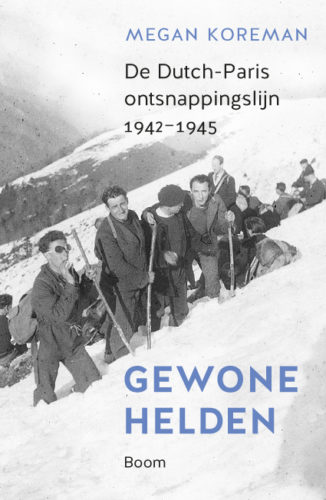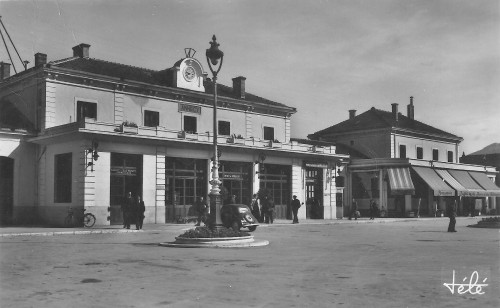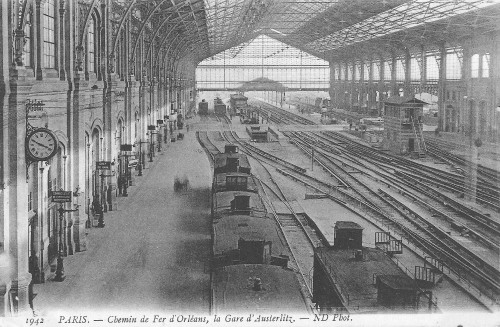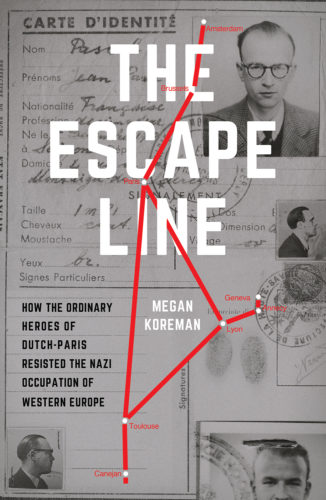Searching for the Dutch-Paris Escape Line
Resisters’ Families
I’ve been thinking about resisters’ families since my last blog but I can’t come to any conclusion. The men and women of Dutch-Paris had many different family situations during the war. Weidner himself was married, but did not have children. There were widowed women with grown children; young men and women who lived with their parents; bachelor businessmen in their 30’s; men in their 40’s or 50’s who lived with their wives and children, and single Jewish men and women who knew that the rest of their families had been deported “to the east.”
Furthermore, the families don’t often come up in the documents. The documents ask what actions an individual took. They never, ever, ask how that individual’s mother felt about any of it. But there are a few hints. In some families, the men kept the women in the dark in the hopes of protecting them from anxiety. An Engelandvaarder said that his father came to say good-bye and give him some foreign currency but he left without telling his mother or sisters. A resister said that he sewed his own secret pocket because he didn’t want to Read the rest of this entry »
A Resister’s Parents
I had the great honor of visiting with Joke Folmer a few weeks ago in Amsterdam. She is well known for having escorted hundreds of downed Allied aviators out of the Netherlands, some of whom she passed to Dutch-Paris.
Among other things, I was interested to ask how she knew where to go when she went to a new contact in a new town because I myself had missed a turn on my rented bicycle that very morning and ended up taking the longest possible route to our meeting place. Apparently getting lost was not a problem in occupied Holland because she passed aviators over at train stations or on bridges. I think Mevrouw Folmer must also have a much better sense of direction than I do.
But of all the things that we talked about, what has stayed with me is this. Joke Folmer was a very young Read the rest of this entry »
Why Did Resisters Resist?
I’d like to share some of the discussion at the book launch symposium in Amsterdam last month. Unfortunately I didn’t have anything to write with, so this is not as detailed as I’d like.
Professor Hans Blom began the discussion by reminding us all that a person needed both the desire to be a resister and the opportunity to do something in order to join the resistance. Then Ad van Liempt talked about why some people chose to join the resistance. Jean Weidner, for example, felt very strongly that it was his Christian duty to resist the occupier by helping the persecuted. Other resisters also felt compelled by their strong Christian beliefs.
As he said later in private, today you might even call Weidner and these other Christians religious fanatics, but you would also applaud their resistance.
During the discussion, however, Max van Weezel asked me if Weidner’s strong Christian beliefs were shared by everyone in Dutch-Paris. The answer is definitely “no”. Dutch-Paris had a strikingly ecumenical membership ranging from Catholic priests, Protestant ministers, church-going lay people, to Jews to atheists. There was even a communist of the non-Soviet variety.
Dick Verkijk made an interesting observation from the audience. Mr Verkijk had a long career as a journalist in the Netherlands. In fact, he made the 1967 documentary about Dutch-Paris (available on Youtube with English subtitles, follow the link in the side bar). So he met and interviewed many resisters. In his opinion, those men and women experienced joy in resistance despite the dangers because they were taking action against the occupation. As he said, if you do not accept unfreedom, you are free. So resisters were free in unfree circumstances because they refused to accept those circumstances.
Although many books have been written on why some people chose to resist while most did not, I don’t think we’ll ever have a satisfactory answer. For one thing, no one asked that question at the end of the war because it seemed self-explanatory then. I also suspect that the answer would change slightly for each man and woman. We could certainly have continued that discussion for much longer at the symposium if we’d had more time.
What we could conclude at the symposium, however, was that all resisters were men and women of strong conviction. That conviction might have stemmed from religious beliefs or patriotic anger or other causes, but wherever it came from, it was the strength of their convictions that made them resisters (along with the opportunity to do something, of course).
The Making of Dutch-Paris Symposium a Great Success
I think that everyone can agree that the launch of the Dutch translation of my book on Dutch-Paris, Gewone Helden (Ordinary Heroes), in Amsterdam on 10 November 2016 was a great success. Many thanks to Maarten Eliasar and his extended family for organizing the symposium and watching over every last detail.
Just over 280 people came to the symposium at the Amsterdam Hilton, including family members of 18 Dutch-Paris resisters and several Engelandvaarders and Jewish refugees who were helped by Dutch-Paris. It was a great honor to have them there, especially Joke Folmer, who escorted many Allied aviators across occupied Holland before passing them to Dutch-Paris (and other lines). We were also pleased to be joined by the ambassador of Israel, the consul general of the United States and the consul general of France.
I was on a strict time table, so I told the short version of Read the rest of this entry »
How do you Send Mail to Someone Living Underground?
Here’s an interesting question that came up during the proof reading for the Dutch translation of the book.
Before the days of commercial air travel and cheap long distance phone calls, let alone the internet, travel took time and involved a lot more surprises than it does today. You might set out for a foreign city without knowing where you would stay or exactly when you would be there. But how could the people back home contact you if you did not have an address? The post offices had a device for this situation called “poste restante.” The person back home addressed the envelope to a name, a city and “poste restante”. The traveler went to that particular post office in the city and asked if there was any mail for him or her. It worked quite well if no one was in a hurry.
Paris being the gigantic city that it is, you could address “poste restante” mail to train stations as well as post offices. This was, of course, very convenient because even if you were just passing through Paris, you could pick up your mail.
During the war, one of Dutch-Paris’s leaders told his comrades that they could send him messages addressed to “Mr van den Hove uit [from] Bending” poste restante at the Gare St Lazare. Mr van den Hove was obviously a false name. But the copy editor wanted to know about the town of Bending. Where was it? Was it spelled correctly? Because there is no Read the rest of this entry »
- 0 Comments
- Tags: aliases, France
I am happy to report that the Dutch translation of my book on Dutch-Paris has arrived from the printers. Many thanks to Maarten Eliasar, Hélène Lesger and the rest of the production team for the terrific job they did with the translation, the copy editing, the illustrations and all the details that have made it such a fine looking book. It will be at Dutch bookshops starting this weekend. (Gewone Helden: de Dutch-Paris ontsnappingslijn 1942-1945, ISBN 978 90 5875 5568).
Also this weekend, the Dutch tv programme Andere Tijden will broadcast an episode called Ontsnappingsroute in de oorlog (Escape Route during the War). It will air at 21.10 on Saturday 5 November on NPO2. You can follow this link for the preview (in Dutch and some French) http://www.anderetijden.nl/programma/1/Andere-Tijden/aflevering/682/Ontsnappingsroute-in-de-oorlog The link includes a sublink to the 1967 Dutch documentary about Dutch-Paris, which has footage of many of the line’s leaders.
I have not been involved in making the documentary, but every researcher’s favorite archivist, Sierk Plantinga has been interviewed extensively for it. Some of you may have already seen him talking about a postcard sent from the Third Reich on the tv preview for the show. I don’t know if the entire show is about Dutch-Paris, but at least part of it is. I can’t wait to see it.

The Train Stations Used by Dutch-Paris
If you read the earlier post about trains, you know that a lot has changed about railway journeys since 1944. Another thing that has changed in some places, is the train stations. On a small scale, you used to have to buy a “platform ticket” in order to enter the platforms. So if you wanted to walk your sweetheart to the door of the train to bid him or her a tearful adieu, you needed to buy yourself a ticket to get that close to the train. This could have unexpected consequences. In December 1943 a Dutch-Paris guide could not get platform tickets for the early train out of Toulouse. When she came back for the afternoon train, the Gestapo arrested her on the platform.
On a larger scale, some of the train stations have changed beyond recognition. The station in the small mountain town of Annecy, for example, has been completely rebuilt in the last five years. It is now an ultramodern structure of glass and steel. During the war it looked like this:
If you took a train from Paris to Lyon Read the rest of this entry »
Wartime Railway Journeys
If you were to trace the steps of Dutch-Paris couriers and guides, you would do most of it by train. Like all civilians during the occupation, they relied on the railway to get themselves and those they were helping from one city to another. So you could get on a train in Amsterdam and follow the same route as an Engelandvaarder to Toulouse.
But you could not entirely re-create the journey. Obviously, Europe is not at war and who would really want to experience the anxiety of Gestapo identity checks and possible air raids? But there are more peaceable differences between then and now as well.
The European Union has abolished the international border crossings, so you no longer have to get off the train, shuffle through customs and passport control, and get back on the train when leaving one country and entering another.
There are also fewer trains now than there were in 1944. Belgium had an impressively dense network of trains and tram, many of which have been replaced by roads for automobiles. Likewise, many of the current roads in the Pyrenees were train tracks in 1944.
The trains themselves were different as well, as you can see in this postcard of the Gare d’Austerlitz in Paris.  Many of them had first, second and third class carriages. Only the most modern of them had the connecting carriages that we take for granted today. The upside of the old-fashioned trains in which you had to get off the train altogether and walk along the platform to get into the next carriage, was that the German police didn’t much care for them. At least in the Pyrenees, they preferred the modern trains with carriages that they could walk between while the train was in motion and rarely controlled passports in the old fashioned trains.
Many of them had first, second and third class carriages. Only the most modern of them had the connecting carriages that we take for granted today. The upside of the old-fashioned trains in which you had to get off the train altogether and walk along the platform to get into the next carriage, was that the German police didn’t much care for them. At least in the Pyrenees, they preferred the modern trains with carriages that they could walk between while the train was in motion and rarely controlled passports in the old fashioned trains.
Wartime trains were also big polluters, billowing out huge clouds of steam laden with coal dust. Today you need to visit a railway museum to smell that particular combination of hot, damp coal and metal. The steam of the trains created its own atmosphere in the train stations as well as causing continual negotiations among passengers about opening or shutting the windows. Closing them kept out the soot. Opening them allowed for the possibility of some air as well as lessening the impact of any possible explosions. None of the trains, even the most modern, had air conditioning.
In fact, compared to today’s high speed, international train travel, even the most uneventful first class train journey during the occupation was slow, inconvenient and uncomfortable. But it was the best available and the men and women of Dutch-Paris relied on it.
- 0 Comments
- Tags: Border Crossings
Dutch-Paris, the Book and the Symposium
I am pleased to announce that Boom uitgevers Amsterdam will publish the Dutch translation of my book this November. Gewone Helden: de Dutch-Paris ontsnappingslijn 1942-1945 (ISBN 978 90 5875 5568) will be available at book sellers or as an e-book starting on 5 November 2016. Oxford University Press will publish the English edition in early 2018. And, yes, I do use everyone’s real name in the book and there are photographs of some of the resisters and the people they helped.
Oxford University Press will publish the English edition in early 2018. And, yes, I do use everyone’s real name in the book and there are photographs of some of the resisters and the people they helped.
To celebrate the release of the book, we invite you to a mini-symposium on Dutch-Paris to be held at the Amsterdam Hilton on the afternoon of Thursday, 10 November 2016. I will tell the short version of the story of Dutch-Paris. Then we will have a lively discussion with a panel of experts and the audience. The experts include Hans Blom, historian and former director of NIOD; Ad van Liempt, author, journalist and tv producer; Onno Sinke, historian and advisor at Arq Psychotrauma Expert Groep, and Max van Weezel, political scientist, journalist and radio anchor. The symposium will be held in English.
The mini-symposium is, of course, free of charge. But we ask anyone who intends to join us to please register so that we have enough chairs and coffee cups for everyone. You can register very easily by clicking on the blue “symposium” tab above or clicking on this link. They both take you to the same place. Please register as soon as possible, but certainly before 20 October.
If you have a family connection to Dutch-Paris because, for example, your mother or grandfather worked in the line or was helped by it, please let us know by sending a message to the symposium’s host, Maarten Eliasar, at amsterdam@dutchparis.com.
For those of you who enjoy quality documentaries, the Dutch tv program ‘Andere Tijden ’ will feature Dutch-Paris in the episode “Ontsnappingsroute in de oorlog” at about 21.10 hours on 5 November 2016 on Dutch public network NPO2. No one is more curious to see this than I am, because although it is based on my book, I’ve had very little to do with it. I do know that they have interviewed individuals who were involved with the line in one way or another.
That will be an exciting week for me and everyone who has been involved in the book. We hope to see you at the mini-symposium on 10 November.
The Fugitive Needed a Doctor
Rescuing people during the Second World War the way Dutch-Paris did was one of those projects that just keep getting more complicated the further you get into it. It sounds straight forward enough: take a person from point A to point B. Of course there are obvious problems such as money, false documents and transportation. But there are also a whole host of secondary problems lurking in the details. Medical care, for example.
During the occupation, many civilians suffered from chronic medical problems because of the shortages of food and heating fuel and, for some, the bone-weary fatigue that comes from spending nights in air raid shelters. In addition to the general hunger and cold, some of the people whom Dutch-Paris helped also had to hide in confined spaces without fresh air or exercise for long periods. In addition, few of the aviators whom they rescued had been injured when their airplanes crashed or they had bailed out.
The shortages that sapped civilians’ health also compromised the public health services, starting with the number of doctors available. In France some doctors spent the war as POWs. In the Netherlands some doctors lost their licenses by refusing to cooperate with the Nazis. And everywhere Jewish physicians were forbidden to practice. Those doctors and nurses still at their posts did not Read the rest of this entry »
- 0 Comments
- Tags: Allied airmen, Belgium, France, The Netherlands
